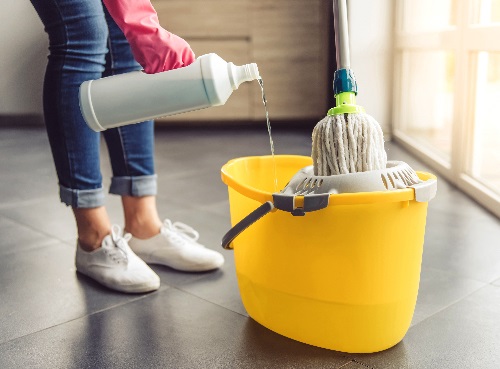With some states reopening businesses sooner than expected, now more than ever, protecting yourself from Covid-19 is crucial. That means maintaining social distancing, protecting yourself and others by wearing a mask, and practicing good social hygiene. Still, that may not be enough. Anywhere people gather will become a breeding ground for germs. If you’re serious about minimizing your chances of getting ill, you’ll need to disinfect your home daily. Here’s the ultimate guide to home disinfection.
BREAKING: Newly Legalized Herb Relieves Pain - Available Without A Prescription
What’s lurking inside your home
If you’re like many Americans these days, you’re probably more aware of the germs you and your family carry into your home. Washing your hands, says the Center for Disease Control and Prevention (CDC) is one of the best ways to protect you and your family from getting sick. But the coronavirus, along with other pathogens, can still cling to clothes, shoes, cell phones, purses, wallets, and more. And that means viruses could be living and breeding on surfaces frequently touched by you and your family. In fact, you might be surprised to find out where germs hide out the most in your home.
A study conducted by the National Sanitation Foundation found that the kitchen — not the bathroom — is by far the worst offender when it comes to collecting germs. Coliform bacteria, which includes salmonella and E. coli, were found on dish rags, in kitchen sinks, on countertops and cutting boards. So, unbeknownst to many, the kitchen contains more bacteria and fecal matter than any other area in the home. And, since germs thrive in moist, warm environments, the study also revealed that sponges and coffee reservoirs were two of the top 10 germiest places in the home.
The bathroom was second on the list of dirtiest places in the home. Not surprisingly, the toilet, toothbrush holders, faucet handles, and towels are where most germs reside. So, with this in mind, let’s discuss what you should be doing daily to keep your home germ-free.
Clean first
Since coronavirus can live on surfaces for up to three days, it’s essential to wear rubber gloves or disposable gloves when cleaning and disinfecting. If you choose to wear reusable gloves, they should be dedicated to cleaning and disinfection of surfaces for coronavirus and should not be used for other purposes.
The World Health Organization (WHO) reports that coronavirus can survive for:
- Up to 72 hours on plastic and stainless steel
- Up to four hours on copper
- Up to 24 hours on cardboard
Most importantly, according to WHO, coronavirus living on surfaces can be killed with common household disinfectants. However, surface areas like tables, doorknobs, light switches, faucets, toilets, and sinks that are highly soiled should be cleaned first with detergent and water.
Disinfecting vs. cleaning
Disinfecting is not the same as cleaning. Cleaning removes germs, dirt, and buildup from surfaces with soap and water — but it does not kill germs. Disinfecting, on the other hand, does not clean surfaces. It does, however, kill germs when the correct products are used. Disinfecting after cleaning a surface lowers the risk of spreading infection.
EPA approved disinfectants
Coronaviruses, say the United States Environmental Protection Agency (EPA), are called enveloped viruses. That means they are one of the easiest types of viruses to kill with the appropriate disinfectant product. So, using the correct disinfectant is an important part of preventing and reducing the spread of Covid-19. Some of the registered disinfectants on the EPA’s list include:
- Clorox products, including disinfectant wipes and disinfecting spray
- Lysol products, including heavy-duty cleaners, multi-surface cleaners, concentrates and mists
- Purell products, including surface wipes
Apart from wearing gloves when disinfecting, make sure to read the manufacturer’s instructions on how to use the product. In addition, make sure to have proper ventilation when disinfecting with chemicals.
How to properly disinfect
- Any surface areas that are sticky from spills and dirt should be wiped clean with detergent and water before disinfecting. Follow with a disinfectant.
Disinfect these frequently-touched surfaces daily:
- Countertops and tabletops
- Desks and hard-backed chairs
- Refrigerator handles and cutting boards
- Cupboard knobs and handles
- Doorknobs and light switches
- Sinks, sink faucets and toilets
- Phones, tablets and touch screens
- Remote controls and keyboards
TRENDING: Shed 42 lbs In 30 Days With This Simple Night-time Pill
In addition, wash and disinfect warm, moist environments in your home where germs live and breed, such as:
- Sponges and dishcloths (throw in the washer with hot water and replace dishcloths daily)
- Hand towels (replace daily)
- Coffee reservoir
Using disinfectant wipes
When it comes to disinfecting, wipes are easy and convenient to use. Apart from killing almost 100 percent of bacteria and viruses, disinfectant wipes also remove almost 100 percent of allergy-causing particles, such as pollen, dust mites, and pet dander. They are also safe and effective on electronics.
- Make sure to use enough fresh wipes to wet the surface thoroughly. Allow the area to remain wet for about four minutes and then surface dry. Toss used disinfectant wipes in the trash.
Using a bleach solution
Diluted household bleach solutions of at least 1000ppm sodium hypochlorite may be used to kill germs and viruses on appropriate surfaces. Read and follow the manufacturer’s instructions. Additionally, ensure the product is not past its expiration date.
- Make sure the bleach solution maintains contact for at least one minute.
- Allow proper ventilation during and after application.
- Never mix household bleach with vinegar, ammonia, or any other cleanser.
To make a solution for disinfecting:
- 1/3 cup bleach to 1 gallon of water
- Alternatively, use 4 tsp bleach per 1 quart of water
Using natural solutions for disinfecting
The EPA’s approved list of disinfectants includes the best defense against COVID-19. However, if you’re not a fan of using harsh chemicals, and you prefer a disinfectant that’s easier on the environment, the EPA also approves all-natural products containing the ingredient thymol.
Note: Only some essential oils are effective against specific pathogens like coronavirus, but not all. For instance, clove essential oil works well against salmonella and E. coli bacteria but not against pneumonia-causing bacteria.
So, what exactly is thymol?
Thymol is a compound found in thyme oil. Typically, it’s used in products such as pesticides, animal repellents, fungicidal products, medical disinfectants, and is even used to fight viruses and tuberculosis. It is also used as an additive food flavoring, in perfumes, mouthwashes, and cosmetics. But its many antimicrobial properties are what makes it an ideal all-natural disinfectant. The EPA does list a few approved products that contain thymol. However, you can make your own household disinfectant using thyme oil.
Ingredients
- 2 cups purified water
- 20 drops thyme essential oil
- 1/4 cup citric acid powder
Instructions
- Combine all ingredients into a plastic spray bottle.
- Shake well before use and spray onto surfaces.
- Allow to sit for a few minutes and wipe dry.
BREAKING: Diabetes Breakthrough Leaves Doctors Speechless - Try This Tonight
Yes, this is a lot of disinfecting in one day. However, consider this… With the US surpassing one million cases of coronavirus this month, a little elbow grease may go a long way to keep your home germ free and your family safe. And that means you’re doing your part in stopping the spread of COVID-19.









